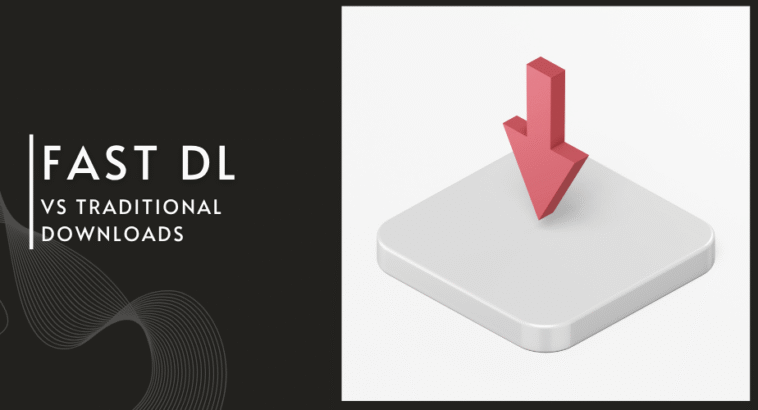Fast DL, or “Fast Download,” is a technology-enhanced method for speeding up file downloads, particularly in gaming and server-based applications. It significantly reduces latency and accelerates data transfer, improving user experience dramatically.
Traditional downloads rely on direct server-to-client transfers without optimization layers. While effective for small files, this method often becomes sluggish and inefficient for larger transfers.
As digital content becomes more sophisticated, so too must the delivery mechanisms. The debate between fast Download and traditional downloads impacts everything from entertainment to enterprise-level file sharing.
How Fast DL Works: The Mechanics Behind the Speed
Server-Side Optimization
Fast Download uses separate HTTP servers to deliver large files, bypassing game or app servers. This decreases server strain and increases bandwidth efficiency.
Client-Side Acceleration
On the user’s end, fast Download minimizes packet loss and buffers data smartly to maintain high-speed transfers, even under suboptimal network conditions.
Key Tech Stack Components
Fast Download often integrates CDN (Content Delivery Networks), HTTP/2 protocols, and compression algorithms like Brotli or GZIP to accelerate performance.
Traditional Download Methods: Still Relevant?
Direct Server-to-Client Transmission
Traditional downloads operate on a one-to-one server-client ratio. This simplicity makes it reliable, but limits scalability and speed under high loads.
Bottlenecks and Limitations
Network congestion, server load, and lack of smart routing all contribute to slower download speeds and potential interruptions.
When Traditional Still Works
Smaller file sizes or environments with limited infrastructure might still benefit from the straightforward nature of traditional downloads.
Speed Comparison: Fast DL vs Traditional Downloads
Benchmarking Download Speeds
Studies show fast Download can be up to 10x faster than traditional downloads, especially when using high-speed internet and optimized servers.
Real-World User Experience
Gamers and developers consistently report reduced load times and seamless updates when using fast Download -enabled platforms.
Impact on Mobile and Broadband Users
Fast Download adapts better to mobile data variability, while traditional downloads often stall or drop completely under similar conditions.
User Experience and Accessibility
Faster Onboarding and Updates
Fast Download reduces the time it takes to install and update applications, leading to improved user satisfaction and retention.
Multiplatform Support
Fast Download is increasingly available across platforms—PC, consoles, and mobile—making it more accessible to modern users.
Inclusive Access in Low-Bandwidth Regions
Through CDNs and caching, fast Download ensures users in remote or low-speed regions can access files without major delays.
Security and Reliability of Fast Download
Encrypted Transfers and HTTPS
Most fast Download setups use HTTPS for secure data transfer, ensuring protection against interception and tampering.
Integrity Checks and Redundancy
MD5 and SHA checksums validate data integrity, while mirrored servers offer fallback options in case of download failure.
Comparison with Traditional Security Protocols
While traditional downloads also use secure channels, they often lack redundancy and real-time integrity verification, making them more susceptible to corruption.
Scalability and Server Load Management
Load Distribution with Fast Download
Fast Download leverages dedicated servers and CDNs to offload primary servers, maintaining stable performance even during high traffic spikes.
Traditional Systems Under Strain
When user demand spikes, traditional download methods can crash or slow significantly due to lack of dynamic resource allocation.
Cost Efficiency in Scaling
Organizations using fast Download save costs in the long term through lower maintenance and more efficient bandwidth utilization.
Integration and Compatibility
Implementing Fast Download in Games and Apps
Most modern game engines like Source and Unity support fast Download out-of-the-box or via easy integration, reducing development time.
Compatibility with Cloud Systems
Fast Download naturally aligns with cloud-native architectures, allowing seamless updates, patch management, and content delivery.
Challenges with Legacy Systems
Older platforms may need manual updates or server reconfigurations to utilize fast Download effectively, requiring some technical investment.
Real-Life Applications of Fast Download
In the Gaming Industry
Fast Download powers smooth mod downloads, server updates, and map transfers, improving multiplayer experience and reducing downtime.
In Enterprise Environments
Large corporations use fast Download for software deployments and file synchronization across global offices, enhancing operational efficiency.
Beyond Tech: Educational and Media Platforms
Universities and streaming services benefit from fast Download by offering quicker access to large files like video lectures or 4K content.
Misconceptions and Myths About Fast Download
“Fast Download Isn’t That Different”
The performance difference, especially under load, is measurable and significant compared to traditional download methods.
“It’s Too Complicated to Set Up”
Modern tools and platforms offer plug-and-play solutions for fast Download , making it accessible even to small development teams.
“Only Gamers Need Fast Download “
While gaming led its adoption, industries from e-learning to healthcare now rely on fast Download for time-sensitive data delivery.
Environmental Impact and Resource Efficiency
Fast Download and Energy Efficiency
Fast Download reduces server strain and data transmission times, which can lower power consumption at both the server and client level. This makes fast Download not only efficient for users but also better aligned with sustainable tech practices. Reduced CPU cycles and minimized bandwidth usage lead to greener digital delivery systems.
Traditional Downloads and Infrastructure Load
Traditional downloads require more prolonged server-client interaction and repeated data requests, especially during interruptions. This leads to excess energy use and unnecessary server overuse, particularly when files fail midway and need to restart from the beginning.
Cloud-Centric Delivery Models
Fast Download synergizes well with cloud infrastructure, using virtualized environments and dynamic load balancing. This reduces the need for physical server farms and long-term maintenance, further minimizing environmental impact compared to traditional static-hosted downloads.
User Behavior and Download Preferences
Modern User Expectations
Today’s users expect near-instantaneous access to content. Fast Download caters to this demand with rapid delivery, minimal waiting times, and intuitive file retrieval processes. The faster the experience, the more likely users are to engage consistently.
Behavioral Analytics and Fast Download
Platforms using fast Download often incorporate analytics to measure performance and optimize delivery based on user behavior. Insights like time-to-download and device type help tailor the download process and improve UX across devices.
Why Speed Affects Retention
Statistics show that slow downloads lead to increased bounce rates. By implementing Fast Download, companies can retain more users, reduce cart abandonment in e-commerce, and improve engagement in gaming, education, and media sectors.
Comparing Data Integrity and Recovery Features
Fast Download and Smart Resume Capabilities
Fast Download systems are designed to allow interrupted downloads to resume without re-downloading the entire file. This intelligent handling saves time, preserves bandwidth, and ensures a smoother user experience.
Traditional Downloads: A Fragile Process
In traditional systems, any disruption—like a dropped connection or app crash—may result in a corrupted or failed download. Users often must start over, leading to frustration and wasted time.
Automatic Error Correction
Fast Download includes built-in redundancy and checksum verification to detect and correct minor file errors during the download process, a feature not commonly available in older traditional download methods.
Fast DL in Edge Computing and IoT Applications
Real-Time Data Delivery
Fast Download is being adapted to serve edge computing environments where data must be delivered swiftly to devices at the network’s edge. This is critical in use cases like smart cities, real-time monitoring, and IoT ecosystems.
Lightweight Updates for IoT
IoT devices, which often operate on limited bandwidth and processing power, benefit from fast Download protocols that ensure lightweight, incremental updates instead of full-file replacements.
Future-Proofing Smart Environments
As fast Download evolves, its integration into edge networks ensures consistent, reliable updates and file transfers across connected devices, outpacing traditional methods that lack this level of adaptability.
Fast DL vs. Fasting Blood Sugar Level mg/dL: Clarifying the Terms
Common Confusion in Terminology
While Fast Download refers to digital file transfer technology, the abbreviation “fasting blood sugar level mg/dL” relates to medical glucose measurements. Despite sharing a similar acronym, they represent completely different concepts.
Contextual SEO Relevance
For clarity and search engine optimization, it’s important to distinguish Fast Download (digital term) from fasting blood sugar level mg/dL (medical term). This ensures content remains contextually relevant and doesn’t mislead readers or search engines.
Avoiding Keyword Cannibalization
Using clear sub-keywords like fast.dl, file download optimization, and download speed comparison helps maintain focused topical relevance, preventing dilution by unrelated terms like fasting blood sugar level mg/dL, which may appear in medical content.
Conclusion: Why Fast Download Is the Future of Digital Delivery
Fast Download offers clear advantages over traditional download methods: higher speed, greater security, and better scalability. As users demand faster and more reliable access to digital content, fast Download becomes a necessity, not a luxury. Whether you’re a developer, gamer, or enterprise tech leader, understanding and implementing Fast Download will future-proof your content delivery strategies.




